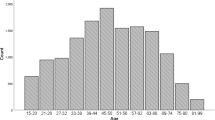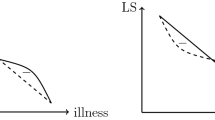Abstract
The aim of this paper is to study the individual and contextual determinants of life satisfaction in Italy. A hierarchical probit model is proposed for studying data with group structure and an ordinal response variable. The group structure is defined by the presence of micro observations embedded with regional contexts (macro observations), and the specification is at both of these levels. The methodology is applied to Eurobarometer survey data, with individuals viewed as micro observations and regions as macro observations. We find that Italy is not an homogeneous country with respect to life satisfaction, and that the regional environment contributes with the observed and unobserved characteristics of the individuals to life satisfaction level.
Similar content being viewed by others
REFERENCES
Aitkin M. and N. Longford: 1986, 'Statistical modelling issues in school effectiveness studies' Journ. Royal Statitst. Soc. A 149, part 1, pp. 1–43.
Anderson D. A. and M. Aitkin: 1985, 'Variance component models with binary response: interviewer variability' Journ. Royal Statitst. Soc. B 47, pp. 203–210.
Andrews F. M. and S. B. Withey: 1976, Social Indicators of well-being (Plenum press, New York).
Campbell A., Converse P. E. and W. Rodgers: 1976, The Quality of American Life (Russel Sage Foundation, New York).
Commisson of the European Community: 1992, Eurobarometer, Trends 1974–1991 (Bruxelles).
Davis E., Fine-Davis M. and G. Meehan: 1982, 'Demographic determinants of perceived well-being in eight European countries', Social Indicators Research 10, pp. 341–358.
Diener E. and C. Diener: 1995, 'The perceived quality of life in Norway: regional variations and contextual effects', Social Indicators Research 36, pp. 275–286.
European Commission: 1991, Eurobarometer, Report on Stadard Eurobarometer 34 (Bruxelles).
European Commission: 1992, Eurobarometer, Report on Stadard Eurobarometer 36 (Bruxelles).
Eurostat: 1996, Regions Statistical Yerbook 1995 (Bruxelles, Luxembourg).
Goldstein H. and M. J. R. Healy: 1995, 'The graphical presentation of a collection of means' Journ. Royal Statitst. Soc. A 158, pp. 175–177.
Goldstein H. and D. J. Spiegelhalter: 1996, 'League tables and their limitations: Statistical issues in comparisons of institutional performance' Journ. Royal Statitst. Soc. A 159, pp. 385–443.
Gori E.: 1992, 'La valutazione dell'efficienza ed efficacia dell'istruzione', SIS, Atti della XXXVI riunione scientifica 1, pp. 219–230.
Gori E. and C. Rampichini: 1996, 'Modelli a componenti di varianza con risposta ordinale', SIS, Atti della XXXVI Riunione Scientifica 2, pp. 481–488.
Hedeker D. and D. Gibbons: 1994, 'A random-effects ordinal regression model for multilevel analysis', Biometrics 50, pp. 933–944.
Inglehart R. and J. R. Rabier: 1984, 'Du bonheur...Sentiment personnel et norme culturelle', Futuribles 81, pp. 3–27.
ISTAT: 1993, Annuario Statistico Italiano (ISTAT, Roma).
ISTAT: 1995, Annuario Statistico Italiano (ISTAT, Roma).
Jansen J.: 1991, 'On the statistical analysis for ordinal data when extravariation is present', Applied Statistics 39, pp. 75–84.
Longford N. T.: 1993, Random Coefficient Models (Claredon Press, Oxford).
Maddala G. S.: 1983, Limited Dependent And Qualitative Variables (Cambridge University Press, Cambridge).
Mastekaasa A. and T. Moum: 1984, 'The perceived quality of life in Norway: regional variations and contextual effects', Social Indicators Research 14, pp. 385–419
Meadow H. L., J. T. Mentzer, D. R. Rahtz and M. J. Sirgy: 1992, 'A life satisfaction measure based on judgment theory', Social Indicators Research 26, pp. 23–59.
Michalos A.: 1985, 'Multiple discrepancies theory (MDT)', Social Indicators Research 16, pp. 347–413.
Qu Y., Piedmonte M.R. and S.V. Medendrop: 1995, 'Latent variable models for clustered ordinal data', Biometrics 51, pp. 268–275.
Rampichini C.: 1992, 'Metodi Statistici per la valutazione dell'efficienza ed efficacia dei corsi di Formazione Professionale', Working Papers 38 (Dipartimento Statistico, Università di Firenze).
Requena F.: 1995, 'Friendship and subjective well-being in Spain: a cross-national comparison with the United States', Social Indicators Research 35, pp. 271–288.
Schulz W.: 1995, 'Multiple-discrepancies theory versus resource theory', Social Indicators Research 34, pp. 153–169
Sirgy M. J., D. Cole, R. Kosenko, H. L. Meadow, D. Rahtz, M. Cicic, G. Xi Jin, D. Yarsuvat, D. L. Blenkhorn and N. Nagpal: 1995, 'A life satisfaction measure: Additional validational data for the congruity life satisfaction measure', Social Indicators Research 34, pp. 237–259.
Steel D. J. and D. Holt: 1996, 'Analysing and adjusting aggregation effects: the ecological fallacy revisited', Int. Stat. Rev. 64, pp. 39–60.
Stones M. J., T. Hadjistavropoulos, H. Tuuko and A. Kozma: 1995, 'Happiness has trait-like and statelike properties: A reply to Veenhoven', Social Indicators Research 36, pp. 129–144.
Veenhoven R.: 1994, 'Is happiness a trait? Tests of the theory that a better society does not make people any happier', Social Indicators Research 33, pp. 101–160.
Veenhoven R.: 1996, 'Developments in satisfaction-research', Social Indicators Research 37, pp. 1–45.
Veenhoven R. and J. Ehrhardt: 1995, 'The cross-national pattern of happiness: Test of predictions implied in three theories of happiness', Social Indicators Research 34, pp. 33–68.
Wong G. Y. and W.M. Mason: 1985, 'A hierarchical logistic regression model for multilevel analysis', JASA 80, pp. 513–524.
Zeger S. L. and R. M. Karim: 1991, 'Generalized linear models with random effects: A Gibbs sampler approach', J. Am. Statist. Ass. 86, pp. 79–86.
Author information
Authors and Affiliations
Rights and permissions
About this article
Cite this article
Rampichini, C., Schifini d'Andrea, S. A Hierarchical Ordinal Probit Model for the Analysis of Life Satisfaction in Italy. Social Indicators Research 44, 41–69 (1998). https://doi.org/10.1023/A:1006888613727
Issue Date:
DOI: https://doi.org/10.1023/A:1006888613727




